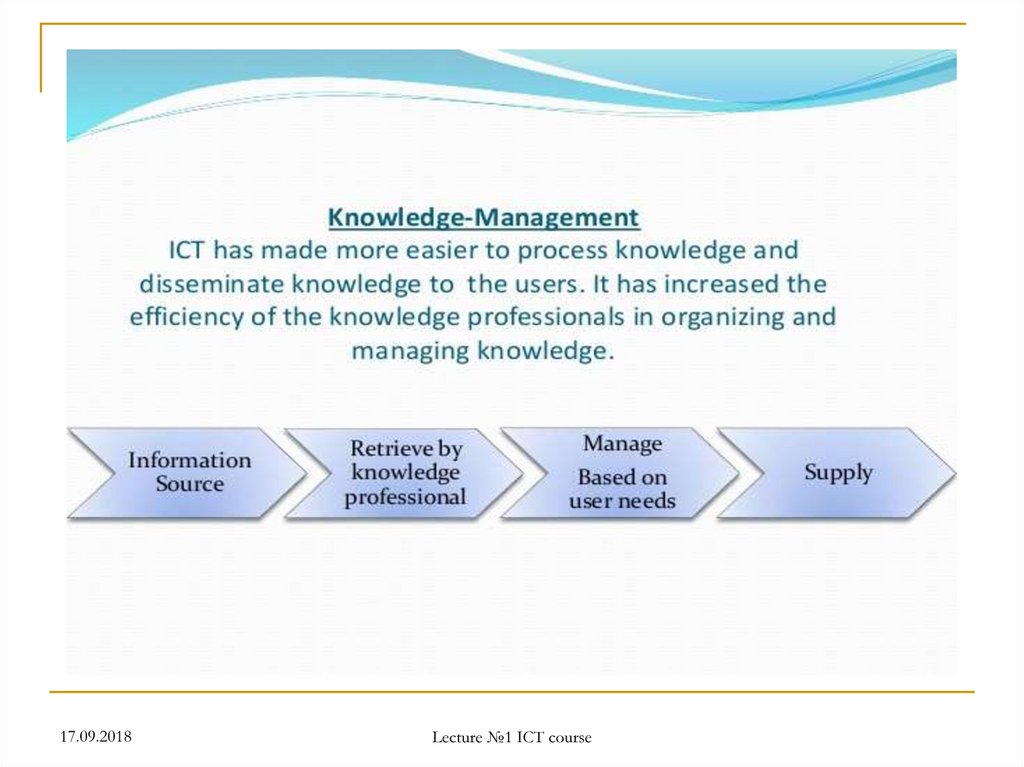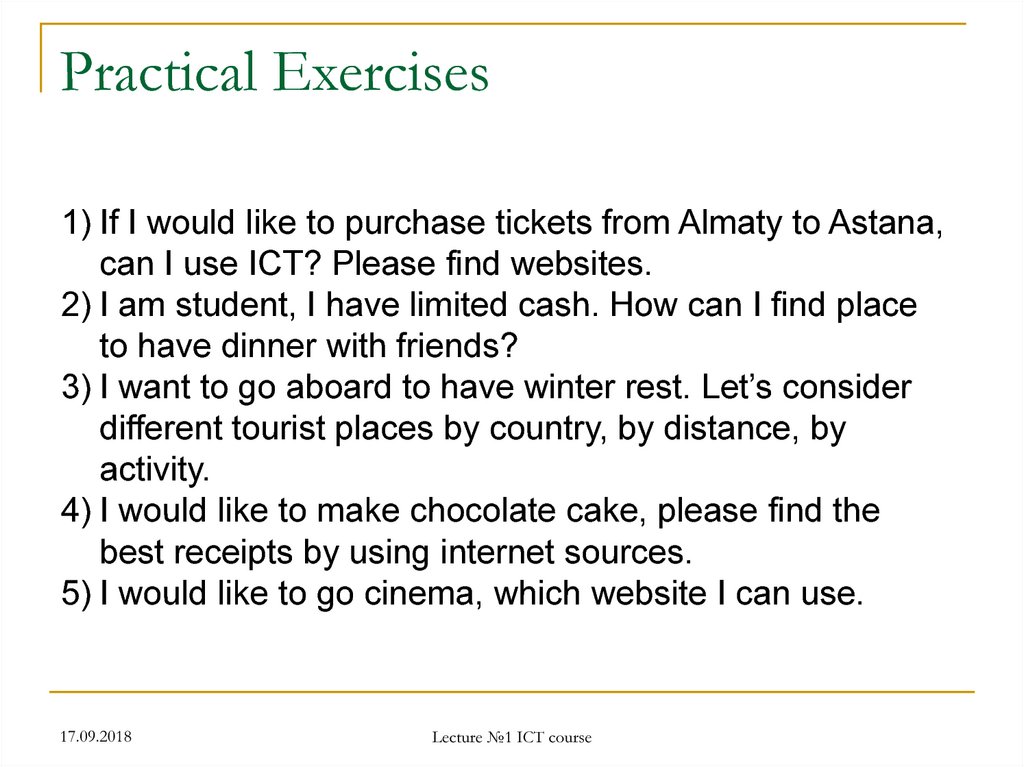Similar presentations:
Role of ICT in the key sectors of development of society. Standards of ICT
1. Role of ICT in the key sectors of development of society. Standards of ICT
17.09.2018Lecture №1 ICT course
2. Lecture’s Outline
What is ICT?Why study ICT?
Computer and Communication Technology
What is application of ICT?
What is the role of ICT in our life?
Changes in life of human being with development of ICT
Digital&Analog data
Binary Representation
Standards of ICT
17.09.2018
Lecture №1 ICT course
3.
17.09.2018Lecture №1 ICT course
4.
17.09.2018Lecture №1 ICT course
5.
17.09.2018Lecture №1 ICT course
6.
17.09.2018Lecture №1 ICT course
7.
17.09.2018Lecture №1 ICT course
8.
17.09.2018Lecture №1 ICT course
9.
17.09.2018Lecture №1 ICT course
10.
Another definition of ICTICT is defined as an industry, i.e. as a set
of enterprises and organizations engaged in
economic activities related to the design,
production and trade of software, computing,
communications equipment, consumer
electronics and its components, as well as
system integration, with the provision of
telecommunication and information technology
services (According to the Order of the Minister of
Information and Communication of the Republic
of Kazakhstan in Industry frame of qualifications).
17.09.2018
Lecture №1 ICT course
11.
One more definition of ICTAccording to the definition of Development Program of
Organization of United Nations in 2003 :
ICT is, mainly, a tool for processing information - a wide range of
products, software and services that are used for production,
storage, processing, distribution and exchange of information. They
also include "old" ICTs, including radio, TV and telephone, as well as
"new" ICT: computers, satellite systems and wireless technologies
and the Internet. These different tools are now able to work together,
and together they make up our "network world", a gigantic structure
of the combined telephone networks, standardized computer
hardware, Internet, radio and television, while using these
components can be easily accessed in anywhere in the world.
17.09.2018
Lecture №1 ICT course
12.
As last one definitionInformation and communication technologies
(ICT) in the discipline are regarded as
modern methods and means of
communication of people in a normal and
professional activities with the help of
information technologies for the search,
collection, storage, processing and
dissemination of information.
17.09.2018
Lecture №1 ICT course
13.
17.09.2018Lecture №1 ICT course
14.
17.09.2018Lecture №1 ICT course
15.
17.09.2018Lecture №1 ICT course
16.
17.09.2018Lecture №1 ICT course
17.
17.09.2018Lecture №1 ICT course
18.
17.09.2018Lecture №1 ICT course
19.
17.09.2018Lecture №1 ICT course
20.
17.09.2018Lecture №1 ICT course
21.
17.09.2018Lecture №1 ICT course
22.
17.09.2018Lecture №1 ICT course
23.
17.09.2018Lecture №1 ICT course
24.
17.09.2018Lecture №1 ICT course
25.
17.09.2018Lecture №1 ICT course
26.
17.09.2018Lecture №1 ICT course
27.
17.09.2018Lecture №1 ICT course
28.
17.09.2018Lecture №1 ICT course
29. Role of ICT in Kazakhstan society
The population’s computer literacy as of 2015 is 64.1%.The number of internet users in 2016 is 12 million people, it’s
70%.
ICT is successfully develop in our country, our new generation
use new ICT in life.
All Kazakhstan banks has own internet banking system, which
match international standards
KazakhstanTemirJoly, AirAstana, QazaqAir, BekkAir, Skat and
etc has own traffic control system
There are E-gov system, United system for hospitals, United
Taxpayers System, and etc.
Kazakhstan government have strong support for development
and using of ICT.
KazakhTelecom and all internet providers support development
of internet spread in all the regions of Kazakhtan.
17.09.2018
Lecture №1 ICT course
30. Computing Systems Data
Usually the computing systems are complexdevices, dealing with a vast array of
information categories
The computing systems store, present, and
help us modify:
17.09.2018
Text
Audio
Images and graphics
Video
Lecture №1 ICT course
31.
17.09.2018Lecture №1 ICT course
32. Digital vs. Analog
Computing systems are finite machines. They store a limited amountof information, even if the limit is very big.
The goal, is to represent enough of the world to satisfy our
computational needs and our senses of sight and sound.
The information can be represented in one or two ways: analog or
digital.
Analog data is a continuous representation, analogous to the actual
information it represents.
Digital data is a discrete representation, breaking the information up
into separate (discrete) elements.
17.09.2018
Lecture №1 ICT course
33.
Binary RepresentationWhy binary representation (as suppose to
decimal or octal, etc..)?
17.09.2018
Because the devices that store and manage the
digital data are far less expensive and complex
for binary representation.
They are also far more reliable when they have to
represent one out of two possible values.
Because the electronic signals are easier to
maintain if they carry only binary data.
Lecture №1 ICT course
34.
Binary Representation (2)One bit can be either 0 or 1. Therefore, one bit can
represent only two things.
To represent more than two things, we need multiple
bits. Two bits can represent four things because
there are four combinations of 0 and 1 that can be
made from two bits: 00, 01, 10,11.
In general, n bits can represent 2n things because
there are 2n combinations of 0 and 1 that can be
made from n bits. Note that every time we increase
the number of bits by 1, we double the number of
things we can represent.
17.09.2018
Lecture №1 ICT course
35. Standards of ICT
Allow communication and sharing of informationAllow computing systems and software to
interoperate (at both hardware and software
levels)
Sometimes standards are arbitrary and have
some “blast from the past” (due to historical
evolution)
17.09.2018
Lecture №1 ICT course
36. Standards Organizations
ISO – International Standards OrganizationIEEE – Institute for Electrical and Electronics
Engineers
ANSI – American National Standards Institute
17.09.2018
Lecture №1 ICT course
37. Examples of Standards
Type of DataStandards
Alphanumeric
ASCII, Unicode
Image
JPEG, GIF, PCX, TIFF, BMP, etc
Motion picture
MPEG-2, MPEG-4, etc
Sound
WAV, AU, MP3, etc..
17.09.2018
Lecture №1 ICT course
38. Alphanumeric Data
Three standards for representing letters(alpha) and numbers
17.09.2018
ASCII – American Standard Code for Information
Interchange
EBCDIC – Extended Binary-Coded Decimal
Interchange Code (not used anymore, used to be
used in IBM mainframes)
Unicode
Lecture №1 ICT course
39. Codes and Characters
The problem:Representing text strings, such as
“Hello, world”, in a computer
Each character is coded as a byte ( = 8 bits)
Most common coding system is ASCII
ASCII = American National Standard Code
for Information Interchange
Defined in ANSI document X3.4-1977
17.09.2018
Lecture №1 ICT course
40. Unicode
The extended version of the ASCII characterset is not enough for international use.
The Unicode character set uses 16 bits per
character. Therefore, the Unicode character
set can represent 216, or over 65 thousand,
characters.
Unicode was designed to be a superset of
ASCII. That is, the first 256 characters in the
Unicode character set correspond exactly to
the extended ASCII character set.
17.09.2018
Lecture №1 ICT course
41. Practical Exercises
1) If I would like to purchase tickets from Almaty to Astana,can I use ICT? Please find websites.
2) I am student, I have limited cash. How can I find place
to have dinner with friends?
3) I want to go aboard to have winter rest. Let’s consider
different tourist places by country, by distance, by
activity.
4) I would like to make chocolate cake, please find the
best receipts by using internet sources.
5) I would like to go cinema, which website I can use.
17.09.2018
Lecture №1 ICT course
42. Quiz
I prepared small quiz for you in order tounderstand how did you understand
17.09.2018
Lecture №1 ICT course










































 law
law








